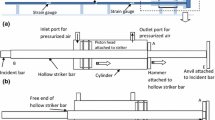Abstract
Background
The stress-state and stress equilibrium of the specimen are the basic things in SHPB tests. However, the relevant research of linear hardening plastic materials is not in-depth.
Objective
This study aims to obtain the stress-state of linear hardening plastic specimen in SHPB tests, and to study the main factors affecting the stress equilibrium.
Methods
By using the conservation condition of continuous wave quantity and the superposition principle, and by reasonably assuming the linear elastic–plastic boundary line, the stress distribution equation of the linear hardening specimen is obtained. Its correctness is verified by comparing with the numerical simulation and experimental results.
Results
Rectangular and Trapezoidal incident stress pulses are conducive to high strain rate loading and faster stress equilibrium, and the appropriate rise time of Trapezoidal pulse is 1.5 to 6 times the elastic wave transits time in the specimen, the best is twice. Local oscillation has an adverse impact on the stress equilibrium, which shall be reduced to within 5% of the maximum loading stress. In addition, the Chord and Slope incident stress pulses are applicable to the case of specimen –bar relative impedance less than 0.5, and the appropriate rise time of Chord incident stress pulses should be less than 10 times the elastic wave transits time, but the Slope incident stress pulses have no such limitation.
Conclusion
In the SHPB test scheme design, different incident waveforms should be selected according to the actual situation of specimen –bar relative impedance and area ratio to meet the loading requirements. When the relative impedance changes, the Chord wave and Slope incident pulses with longer rise time are less applicable.




















Similar content being viewed by others
Data Availability
All data in this paper is available.
References
Huang B, Fu S, Xiao Y (2021) Uniaxial Compressive Behavior of Granite at High Strain Rates. Rock Mech Rock Eng 54:4695–4721. https://doi.org/10.1007/s00603-021-02535-7
Kolsky H (1949) An investigation of the mechanical properties of materials at very high rates of loading. Proc Phys Soc London B62:676–700. http://iopscience.iop.org/0370-1301/62/11/302
Wang L, Hu S, Yang L et al (2014) Development of experimental methods for impact testing by combining Hopkinson pressure bar with other techniques. Acta Mech Solida Sin 27:331–344. https://doi.org/10.1016/S0894-9166(14)60041-0
Liu W, Yang K, Dou L et al (2022) Mechanical properties and failure modes of CRCB specimen under impact loading. Sci Rep 12: 1–18. https://doi.org/10.1038/s41598-022-15985-y
Pengfei L, Xiaoping Z, Qihu Q (2021) Experimental investigation of rigid confinement effects of radial strain on dynamic mechanical properties and failure modes of concrete. Int J Min Sci Technol 31:939–951. https://doi.org/10.1016/j.ijmst.2021.06.001
Yanlei W, Jianxin T, Zhangyin D et al (2018) Experimental study on mechanical properties and failure modes of low-strength rock samples containing different fissures under uniaxial compression. Eng Fract Mech 197:1–20. https://doi.org/10.1016/j.engfracmech.2018.04.044
Forrestal MJ, Wright TW, Chen W (2007) The effect of radial inertia on brittle samples during the split Hopkinson pressure bar test. Int J Impact Eng 34:405–411. https://doi.org/10.1016/j.ijimpeng.2005.12.001
Li QM, Meng H (2003) About the dynamic strength enhancement of concrete-like materials in a split Hopkinson pressure bar test. Int J Solids Struct 40:343–360. https://doi.org/10.1016/S0020-7683(02)00526-7
Zencker U, Clos R (1999) Limiting conditions for compression testing of flat specimens in the split Hopkinson pressure bar. Exp Mech 39:343–348. https://doi.org/10.1007/bf02329815
Zhu Jue Hu, Shisheng WL (2009) An analysis of stress uniformity for concrete-like specimens during SHPB tests. Int J Impact Eng 36:61–72. https://doi.org/10.1016/j.ijimpeng.2008.04.007
Yang L, Shim VPW (2005) An analysis of stress uniformity in split Hopkinson bar test specimens. Int J Impact Eng 31:129–150. https://doi.org/10.1016/j.ijimpeng.2003.09.002
Zhu J, Hu S, Wang L (2006) Analyses on stress uniformity of viscoelastic materials in split Hopkinson bar tests. Lat Am J Solids Struct 3:9–112. https://doi.org/10.11883/1001-1455(2006)04-0315-08
Bo S, Weinong C (2005) Split Hopkinson pressure bar techniques for characterizing soft materials. Lat Am J Solids Struct 2:113–152
Kolsky H (1953) Stress Waves in Solids. Clarendous Press, Oxford
Ravichandran G, Subhash G (1994) Critical appraisal of limiting strain rates for compression testing of ceramics in a split Hopkinson pressure bar. Journal of the American Ceramic Society 77:263–7. https://doi.org/10.1111/j.1151-2916.1994.tb06987.x
Zencker U, Clos R (1999) Limiting conditions for compression testing of flat specimens in the split Hopkinson pressure bar. Exp Mech 39:343–8. https://doi.org/10.1007/BF02329815
Davies EDH, Hunter SC (1963) The dynamic compression testing of solids by the method of the split Hopkinson pressure bar. J Mech Phys Solids 11:155–179. https://doi.org/10.1016/0022-5096(63)90050-4
Author information
Authors and Affiliations
Contributions
All authors contributed to the study conception and design. Theoretical analysis was performed by W. Wang, J. Yang and G.Q. Deng. Numerical simulation was performed by W. Wang and X.Chen. The first draft of the manuscript was written by W. Wang and J. Yan. All authors commented on previous versions of the manuscript. All authors read and approved the final manuscript.
Corresponding author
Ethics declarations
Conflicts of Interest
The authors declare that there is no conflict of interest.
Additional information
Publisher's Note
Springer Nature remains neutral with regard to jurisdictional claims in published maps and institutional affiliations.
Rights and permissions
Springer Nature or its licensor (e.g. a society or other partner) holds exclusive rights to this article under a publishing agreement with the author(s) or other rightsholder(s); author self-archiving of the accepted manuscript version of this article is solely governed by the terms of such publishing agreement and applicable law.
About this article
Cite this article
Wang, W., Yang, J., Deng, G.Q. et al. Theoretical Analysis of Stress Equilibrium of Linear Hardening Plastic Specimen During SHPB Tests. Exp Mech 63, 1353–1369 (2023). https://doi.org/10.1007/s11340-023-00994-3
Received:
Accepted:
Published:
Issue Date:
DOI: https://doi.org/10.1007/s11340-023-00994-3




